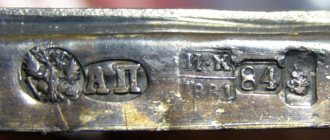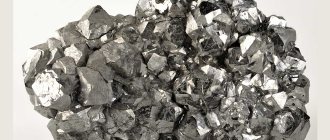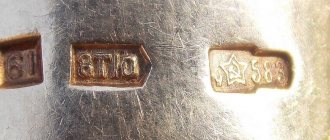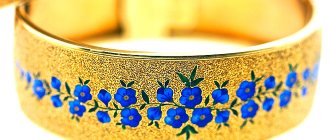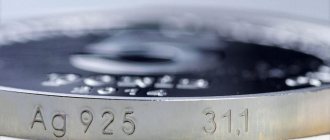Thanks to its natural physical and chemical characteristics, gold has found application in many areas: jewelry industry, chemical industry, medicine, dentistry, etc. Pure precious metal is soft and ductile, which is why it loses its jewelry value. Manufacturers use an alloy of different metals, which increase strength and durability, improving the consumer properties of products.
The ligature composition is very diverse and determines a wide range of gold products.
Ligature and ligature gold - what it is, auxiliary alloys, what it relates to
Most mined metals initially contain unnecessary components. After the reserves are extracted from the earth's crust, the raw materials are processed for further transportation. Dore alloy is made from mined ore that is saturated with different elements. This form allows the future noble metal to undergo refining at specialized plants, where it is purified from impurities.
Pure precious metal itself is quite plastic, which is why it is not suitable for making various items.
However, ligature gold is highly valued by jewelers. By adding other elements, you can change the physical properties of precious metals, improve their wear resistance and appearance.
Alloys of various compositions are used
to solder ligature gold . Ligature involves mixing pure metals with each other, without any impurities. Several purified components can be added to a precious metal at the same time: copper, platinum, silver. The composition is durable and malleable, which is important in the manufacture of jewelry.
In jewelry
In jewelry, a ligature is added to a precious metal to bring the jewelry alloy to a certain standard, to change the color of the alloy, and also to give it various useful properties:
- Increasing the hardness and wear resistance of the metal. Necessary for long-term use of the product.
- Improving malleability, casting properties, increasing/decreasing the melting temperature of the alloy for ease of processing of products by a jeweler.
For gold, the alloy usually consists of silver and copper; platinum, palladium, nickel and zinc are less commonly added.
In silver, the alloying component is copper.
The historical fact of the appearance of ligatures in the monetary system
The physical characteristics of the noble metal became the reason for the search for methods to increase the hardness of gold back in the Middle Ages. Coins made from pure precious metal lost weight and became deformed over time. Then a ligature for gold appeared in the monetary system, which made it possible to prevent the erasure of coins due to the addition of non-ferrous metals.
Gold bars
This decision caused differences between the images on the coins and their actual composition. This difference began to be noticed by the “money changers” of that time, who checked the authenticity of the coins by rubbing them on a mat. Money made of pure gold shrank, lost weight, and the mat accumulated a large amount of the noble metal.
Gradually, the full-value coins in circulation ran out, leaving only the inferior ones. Old means of payment have depreciated.
Jewelry alloys
Pure gold and pure silver are very soft metals, but the alloy of these metals unexpectedly acquires a higher hardness than either of them alone. In addition, it is more ductile, has better malleability than parent metals, and melts at a lower temperature. Those. adding silver to gold improves its properties from a jewelry point of view. Copper and a number of other metals, called base metals, have a similar quality in relation to gold and silver.
The addition of a small amount of silver to gold makes the alloy pale yellow, but if you take gold and silver in equal parts, the yellowness completely disappears. An alloy of gold and copper, on the contrary, looks reddish: copper adds brightness to the noble metal. Therefore, for the jewelry industry, an alloy containing silver and copper is used to obtain a beautiful noble gold hue and high hardness of gold.
Often gold deposits are mined already fused with silver. Such a native alloy containing 45% gold is called electrum. At gold mining enterprises, metals are separated in order to then create various alloys with precisely taken proportions and pre-known properties.
Metals that determine the color of gold
The color directly depends on the composition of the jewelry and the proportion of impurities:
- white shade of sample 585 - the result of an alloy with the base metal of nickel, palladium, platinum, silver, the proportion of noble metal is approximately 59%;
- the red tone is given by the composition of copper;
- the yellow tint of the product is characteristic of pure metal with a slight addition of silver or copper;
- the purple tint is the result of mixing 750 grade precious metal with aluminum;
- black color: alloying metals are ruthenium, chromium, cobalt;
- a green tint is obtained by adding silver and rubidium.
585 white gold
The sample is the same, but the color of gold is different
Products of different colors may have the same sample due to impurities. The proportion of the base metal remains unchanged, only the proportions of the alloys change. The lack of bright shine in the jewelry may indicate the presence of nickel among the components. By adding copper, you can get yellowish tints.
The amount of impurities not only allows you to diversify the color range, but also significantly enhance the strength of the material, as well as provide it with protection from external influences.
Gold of different shades
Palladium and platinum are precious alloys that increase the value of a gold product
The most expensive precious metal admixtures are platinum and palladium. Such a gold ligature is not available to every buyer due to the high cost of jewelry. The price of such a composition significantly exceeds the cost of an item made from other precious metals and is equal to items made from pure noble metal.
The difference between white gold and silver jewelry
Despite the external similarity, there are several differences by which you can find out whether the product is silver or gold
- Try. For silver jewelry it is 925. White gold is found in stores only 585 or 750.
- Gold items are significantly harder than silver items.
- Silver does not shine as brightly as white gold.
A ligature in gold allows you to completely change the properties of the metal, making it possible to obtain real masterpieces. It is thanks to the chemical properties of various alloys that today everyone can find jewelry to suit their taste.
TOP - 4 systems for measuring gold purity
- Zolotnikovaya. It belongs to the outdated measurement systems of the USSR and is practically not used today. The basis is the Russian pound, consisting of 96 spools.
- Metric. Buyers most often encounter this system. The hallmark on jewelry indicates the proportion of gold in the alloy. This indicator helps determine how high quality the product is. The cost depends on the sample.
- Carat. Indicates the gold portion in carat ratio. Applies to Western Europe and North America. In essence, it resembles the metric measurement system.
- Lotovaya. A system for measuring fineness for gold, which was used in Germany until 1888. Using the system, it was possible to determine the number of gold lots in the existing 16.
Sample 56 on a gold ring
general information
Anyone who has ever bought jewelry has noticed that the hallmark indicates in numbers the exact amount of pure gold in the jewelry. Responsible manufacturers place an additional stamp next to the sample, which is called a name tag. Information that can be found from the name, year of manufacture, territorial inspection, individual manufacturer code.
In turn, samples are divided into three measurement systems:
- metric;
- carat;
- spool valve
Buyers more often deal with the metric three-digit system, which indicates the amount of precious metal per kilogram of alloy. During the Soviet era, jewelry of 585 standard was present on the shelves of jewelry stores, where the percentage of other components was 41.7%. Today, such a ratio is very rare, and the most popular is gold 585 alloy. Products with this indicator have excellent performance properties and look great.
Ligature is an alloy that changes the color of a precious metal.
Table: sample ratio between systems
| Piece of pure precious metal | Metric system, standard | Carat system, carat |
| 99,9% | 999 | 24 |
| 95,8% | 958 | 23 |
| 75% | 750 | 18 |
| 58,5% | 585 | 14 |
| 58,3% | 583 | 14 |
| 50% | 500 | 12 |
| 37,5% | 375 | 9 |
Natural materials for ligatures
Ligature threads are made from different materials: silk, flax, catgut, synthetic fibers. Silk ligature is a non-absorbable natural thread. They are distinguished by high strength, which does not disappear over time, and practically do not stretch. Ties securely with two knots. Silk threads of different thicknesses are produced in sterile and non-sterile form. To disinfect silk ligature, steam sterilizers are used, as well as a special Pervomur solution. It is used for emergency cleansing.
Absorbable ligature is a thread made from catgut. They are a natural material made from the muscular part of the small intestine of sheep. It is used for tying subcutaneous tissue, during surgical intervention in the liver structure, for various manipulations that do not require special reliability of threads for tying vessels. Siliconized and chrome-plated catgut, which has higher strength, is also produced.
Imported ligature gold plated price per kg
Most often, foreign jewelry differs from domestic samples. In their composition, the proportion of alloys exceeds the amount of noble metals. American and European standards have a certain similarity with Russian ones, but the hallmark is affixed in carats. You can often buy a fake with a precious coating.
Abroad, low-karat gold is very popular for making jewelry, due to its more suitable consumer characteristics. 9-12 carats are much stronger and harder, they are characterized by high resistance to deformation and scratches. In Russia, products with a lower proportion of impurities are more popular: the higher the standard, the greater the demand.
Ligature with gilding imported
Turkish gold is stamped with three numbers 585. No other designations are provided. A large proportion of the alloy is copper, which can be determined by the excessive redness of the products. Gilded silver items are often passed off as jewelry. Jewelry becomes dull and deformed over time. However, purchases remain at a high level due to the affordable price.
There are also Emirati jewels. They contain a minimal proportion of ligature. Only 2 samples are used: 916 and 958. Jewelry is short-lived, so in the country it is customary to wear them only for weddings. Then the jewelry is simply stored in boxes.
Excerpt characterizing Ligature (metallurgy)
“They told me that you ordered a pawn,” she said, out of breath (she was apparently running), “and I really wanted to talk to you alone.” God knows how long we will be separated again. Aren't you angry that I came? “You have changed a lot, Andryusha,” she added, as if to explain such a question. She smiled, pronouncing the word “Andryusha”. Apparently, it was strange for her to think that this stern, handsome man was the same Andryusha, a thin, playful boy, a childhood friend. -Where is Lise? – he asked, only answering her question with a smile. “She was so tired that she fell asleep in my room on the sofa. Ax, Andre! Que! tresor de femme vous avez, [Ax, Andrey! What a treasure your wife is,” she said, sitting down on the sofa opposite her brother. “She’s a perfect child, such a sweet, cheerful child.” I loved her so much. Prince Andrei was silent, but the princess noticed the ironic and contemptuous expression that appeared on his face. – But one must be lenient towards small weaknesses; who doesn't have them, Andre! Don't forget that she was brought up and grew up in the world. And then her situation is no longer rosy. You have to put yourself in everyone's position. Tout comprendre, c'est tout pardonner. [Whoever understands everything will forgive everything.] Think about what it must be like for her, poor thing, after the life to which she is accustomed, to part with her husband and remain alone in the village and in her situation? It's very hard. Prince Andrei smiled, looking at his sister, as we smile when listening to people whom we think we see right through. “You live in a village and don’t find this life terrible,” he said.
As is known, pure gold has a number of extraordinary physical and chemical properties, but at the same time it is not distinguished by strength and wear resistance. People have long solved this problem by adding other metals (ligatures) to gold alloys.
A strictly defined content of alloy in the alloy significantly improves the quality of the noble metal and increases its service life without compromising its original sunny shine and radiance. What metals are added as an alloy to gold and how does this change the properties of the most noble metal in the alloy?
Gold + Silver
When silver is added, the alloy becomes softer and more malleable, and the melting point decreases. A small silver content turns the color of the alloy yellow-green; as the proportion of silver increases, the color of the alloy becomes pale and acquires a pale lemon color. If the alloy contains 65% silver, it will turn white.
Gold + Copper
Copper added to the alloy, while maintaining the malleability and ductility of the alloy, increases its hardness. At the same time, the color of the alloy acquires a reddish tint, which is familiar to us thanks to domestic jewelry; an increase in the proportion of copper in the alloy only enhances the red tint. There is one significant disadvantage of copper alloy - it reduces the alloy’s resistance to corrosion, which is why it is used in tandem with silver.
Gold + Palladium
The addition of palladium increases the melting point of gold, but the ductility and malleability do not change. Palladium, like silver, makes the alloy turn pale, only at a significantly lower percentage - 10% palladium already gives the alloy a white color. Rarely used for making jewelry, because... is a refractory alloy.
Gold + Nickel
A nickel alloy increases the malleability and ductility of the alloy and significantly increases its hardness. The alloy acquires a pale yellow color.
Gold + Platinum
Platinum increases the melting point of the alloy, increasing its elasticity. The combination of gold and platinum in the alloy successfully prevents the corrosion process. The addition of platinum to a gold alloy gives it a whitish tint; the characteristic yellowness of gold disappears already at a content of 8.4% platinum in the alloy.
Gold + Cadmium
Cadmium as an alloying additive preserves the malleability and ductility of the alloy, but at the same time significantly reduces its melting point. The color of the gold-cadmium alloy varies from yellow to gray, it all depends on the percentage of cadmium in the alloy. The resulting alloy is usually used as solder. In general, such an alloy is used quite rarely in the jewelry industry, since it is a very fragile material.
Gold + Zinc
Zinc lowers the melting point of the alloy, increases its fluidity, and adds noticeable fragility to the alloy and a greenish tint.
On the territory of Russia, the amount of gold in gold alloys is controlled by the state, and, according to Decree of the Government of the Russian Federation of June 18, 1999 No. 643 “On the procedure for testing and branding products made of precious metals”, the following samples of gold jewelry alloys are possible: 375, 500, 585, 750, 958, 999. Other gold samples are not possible in Russia.
In what areas is ligature used?
The admixture is aimed at improving the physical and chemical characteristics of precious metals. A metal additive is introduced when cooking the base, making it refractory. In the process of adding the alloy, experts take into account the loss of metal that occurs during melting. This means that the share of impurities directly depends on the volume of the precious metal after the “waste”. Due to their physical properties, alloys are used in many fields:
- Jewelry craftsmanship. All GOST alloys are represented by alloyed metals. The fineness with the minimum allowable amount of gold is 350, which contains only 35% of it, and is not used for jewelry. However, you can find jewelry of 375 standard. The most popular is 585 red gold. The alloy includes 58.5% precious metal, 20% copper and other impurities. Such products are distinguished by a scarlet tone. You can work with scrap gold in the jewelry industry thanks to a ligature.
- Musical instruments. Ligatures are used in saxophones and other instruments. There is an impurity on the part that is attached to the mouthpiece. The precious alloy part reduces air loss, making the sound especially colorful and drawn-out.
- Dentistry. There is a special ligature alloy for dental braces, which is used to bind the metal and plastic parts attached to the teeth.
- Medicine. Ligature thread is used by surgeons to ligate severely damaged vessels.
- Production of equipment. A strong ligature is used to make many modern gadgets. The electrical connector, microcircuits, and contacts are covered with ligature material.
What is it?
The amount of pure gold is indicated in the hallmark of the jewelry. There are 4 types of samples: metric, carat, spool and lot. The most popular is metric, consisting of 3 digits: they indicate the amount of gold per 1 kilogram of product mass. For example, fineness 999 means that in one kilogram of the alloy there is only 1 gram of alloy - everything else is pure noble metal. But it is unlikely that you will be able to wear such jewelry successfully, due to the softness of the material. There are several samples:
- 375. the lowest sample, in which 62.5% is ligature. Products with such a hallmark are notable for their low cost, but are significantly stronger and more durable than more expensive jewelry;
- 583, “Soviet” gold. Today, the manufacture of goods from this alloy is not carried out. The share of occurrence of other metals is 41.7%;
- 585. The most popular hallmark is a stamp containing these numbers, which are found on almost every piece of jewelry. Perfectly combines high performance characteristics and excellent appearance. The ligature accounts for 41.5% of the total mass;
- 750 sample. This product accounts for 75% pure metal. Products made in this way are highly expensive, since the composition also includes precious metals;
- 958 standard is practically not used in jewelry. Bullions are usually obtained from it, which are then used in the banking industry.
Using a ligature
Ligature in surgery is used mainly to stop varying degrees of bleeding from an injured vessel. The thread, cutting into the tissue during dressing, damages their inner shell. It wraps inside the vessel and leads to the formation of a blood clot, which obstructs the outflow of blood. To avoid the appearance of massive seals, it is necessary, when performing manipulation, to separate large vessels to be ligated from each other. Depending on the goal that needs to be achieved using a ligature, absorbable and non-absorbable threads are used.
After applying a ligature, various complications may arise associated with suppuration of the wound, untying of the knot, and its slipping. Antiseptic treatment of wounds, as well as adherence to the technique of tying vessels, helps to avoid this. Depending on the threads used, different methods of creating knots are used. Some of them are highly reliable, others are used extremely rarely.
Money circulation and the law of money circulation
Money is in constant movement between three entities, such as:
- individuals;
- economic entities;
- government departments.
Money circulation is the direct movement of money when they perform their functions in cash and non-cash form.
Money is concentrated among the population in the cash registers of enterprises, in the current accounts of organizations and in the state treasury. The demand for money arises in the case of transactions, payments for goods and services. The higher the overall value of goods and services, the more money is required to complete transactions. Such monetary circulation is carried out in two main forms:
- cash - those that are in circulation, for example, metal and paper. They provide the purchase of various goods and services. The shortage of metal money creates a problem for buyers and reduces the seller's revenue;
- non-cash money is fixed cash in financial and credit institutions, such as banks, savings banks and in the form of payment orders - requirements. When they are used, money changes hands, not in the form of banknotes, but mainly in the form of inflation.
Along with money, there are other securities in circulation: stocks, bills, bonds, traveler's checks and more.
There is even a law of money circulation. This law was discovered by Karl Marx. It establishes the amount of money needed to perform the functions of a means of circulation and payment.
The amount of money in circulation depends on three main factors:
- the number of goods and services sold on the market;
- price level for goods and services;
- velocity of money circulation.
All these factors are determined by the conditions of production itself. The higher the level of social division of labor, the greater the volume of goods and services sold on the market. And at the same time, the higher the level of labor productivity, the lower the cost of goods and services.
The total amount of money in circulation cannot be unlimited, since in order to sell goods entering the sphere of circulation, the amount of money must be clearly and precisely determined. The greater the sum of prices of goods, the more money is needed to sell them. There is a direct relationship here. The second important element is the speed of circulation of money, since money is constantly returned to circulation. Thus, the faster each monetary unit carries out its turnover, the less money is needed. There is an inverse relationship here.
The amount of money needed for the sphere of circulation is significantly influenced by the function of money as a means of payment. Since the sale of goods on credit means that money is no longer needed for the movement of goods, this reduces the amount of money in circulation and thus increases the sum of the prices of goods that were sold on credit and the payment period for which has already arrived, which requires additional amounts to make these payments . In addition, part of the payments is mutually extinguished. Taking into account all these factors allows us to accurately determine the amount of money needed for circulation.
However, today it is difficult to predict the likely economic situation in the country, as well as on the world market. That is why the requirements of the law of monetary circulation in a market economy are taken into account on the basis of determining the state of monetary circulation, i.e. actual balance and development, as well as the implementation of appropriate monetary policy based on modern monetarism.
From the formulated law we observe an important principle of monetary circulation. Its essence lies in the fact that the money supply must correspond to the needs of circulation. Maintaining balance in the economy, balancing demand, as well as supply, largely depends on the volume of money supply
The money supply should grow in proportion to the growth in the volume of goods and services or decrease in accordance with the decrease in the volume of the commodity supply. Changes in the money supply are determined through the so-called money multiplier, which reflects the role of the banking system in regulating the money supply.
Thus, you can see how all these processes developed throughout history and have reached the present day.
We briefly looked at what a ligature is and related concepts. Leave your comments or additions to the material.
Synthetic materials
Synthetic threads are widely used in medical practice. They are also available as absorbable and non-absorbable. The first include occelon and cacelon. They do not cause allergic or inflammatory reactions and are more reliable than catgut. Non-absorbable synthetic ligature - nylon, nylon, mersilene. They are inferior in strength to silk, in addition, a knot made of these materials can come undone, as they are quite smooth. To prevent this, you need to tie three to five knots. In orthodontic practice, a special ligature is used - elastic. It ties the archwire of the braces. A metal ligature is used to connect bones and joints. The threads must be strong, corrosion-resistant, elastic and smooth. They are made from titanium, silver, nickel wire, steel.
Understanding platinum
Platinum is a precious metal that visually resembles silver. However, this is only the first similarity, which will not be difficult to distinguish. Silver has a warm tint, while platinum is rewarded with a noble white color. Comparing platinum with white gold is not entirely correct, because in fact, white gold has a quite noticeable warm undertone, which is neutralized by the top protective coating of rhodium or ruthenium. Yes, it is possible to alloy white gold without a pronounced warm tint, but in practice this alloy is practically not used.
The minimum purity of platinum does not fall below 850, although the metal usually has an even higher value. The favorite standard of BENSES jewelers is 950 platinum.
Platinum products are more expensive than gold, but few people know why. The opinion has been established that gold is simply cheaper, but in reality this is not entirely true. The initial cost of pure metals per gram is approximately the same, sometimes even platinum can be cheaper. The difference begins to be felt the moment the jewelers get to work.
The 950 platinum alloy is significantly heavier than the 585 gold alloy. To be precise, platinum weighs 21 grams per cubic centimeter, while for gold this figure varies from 13 to 15 grams per cubic centimeter. Weight fluctuations are determined by the ligature.
Accordingly, in two visually similar products made of gold and platinum, the share of the precious metal itself differs significantly. Platinum is required almost twice as much as gold, and the final weight of a platinum product is significantly higher than the weight of gold jewelry. Hence the price difference.
Platinum, with its complex white hue, pairs perfectly with precious stones. The peculiarities of the metal allow you to securely fasten even high-carat stones without fear for the safety of fastening. We use copper, indium and gallium as alloys. When BENDES jewelers need to achieve maximum hardness, we add white gold. Depending on the percentage combination of precious metals, a certain standard is set on the jewelry.
In Russia you can find 850, 900, 950 or 999 platinum.
Understanding gold
Gold is a captivating metal with the largest fan club around the world. Gold has significantly more fineness than platinum, because the metal is widely used in a variety of fields and is more accessible.
Jewelry is usually made from 585 and 750 gold. Since Russians are accustomed to wearing jewelry without removing it, many prefer affordable and beautiful 585 standard, less often 750. Large world brands prefer 750 standard and higher, and in Switzerland it is legally prohibited to use gold below 750 standard in jewelry. In mass production, Europeans use samples 375-417. The hardest alloy metal is 585 white gold.
It is interesting that alloy metals differ from the country of origin and the general stylistic preference in the state. In Europe, more silver is added to the 750 standard, so the shade turns out lighter and colder, but in Russia, on the contrary, girls prefer jewelry made from warm shades of gold mixed with copper. Foreign gold is yellower and less durable, while domestic gold has a more reddish tint and improved strength. Using different variations of the ligature, jewelers give gold different colors: red, white or green.
Sample and ligature indicators
An important point for jewelers and those who are used to knowing exactly what they are choosing. Fortunately or unfortunately, there is no single correct answer which sample and ligature is better. Platinum, as a rule, turns out to be stronger even at low standards, while gold is more common and accessible.
BENDES jewelers do not give preference to any particular metal, but create gold and platinum jewelry with equal love. Reliable, stylish, durable, taking into account your lifestyle and wearing habits of your future jewelry. All jewelry created under the BENDES brand undergoes strict design and technological control, as well as mandatory labeling by regulatory authorities.
BENDES clients
Laysan Utyasheva
Russian athlete, Honored Master of Sports in rhythmic gymnastics, TV presenter and sports commentator.
Oksana Fedorova
Russian TV presenter, philanthropist, fashion model, actress and singer. Miss Russia (2001) and Miss Universe (2002).
Lera Kudryavtseva
Russian television and radio presenter, actress, dancer. She worked for Muz-TV, TNT, TV-6 and NTV.
Natasha Koroleva
Russian singer, actress and fashion model. Honored Artist of the Russian Federation (2004).
Alexander Revva
Russian showman, comedian, TV presenter, singer. Resident of the Comedy Club show.
Methods for obtaining colored gold
There are several ways to obtain colored gold:
- Applying a special coating to the surface of the finished product.
It is carried out due to the thermal and chemical reaction of metal alloys with the environment. - Oxidation.
This method involves creating decoration with artificial colors. An oxide layer is applied to the surface of the jewelry. - Patination.
In this case, chemical treatment of the alloy, which contains copper, occurs. - Oxidation.
Gold products are oxidized in air for 30-60 minutes at a temperature of 750-950 degrees Celsius. Thus, cobalt is used to obtain black gold. - .
Application of rhodium plating on finished products. - Galvanostegy.
This method involves the use of solutions with the addition of special dyes that form a special layer on the jewelry and give it the desired color. - Recoloring gold
is the youngest, recently discovered method of obtaining colored gold. At the atomic level, gold is milled with an ion beam. The structure and depth are selected, light waves are controlled. Thanks to the ability of metals to absorb and reflect waves, any shade of gold can be obtained.
Thus, gold has been valued from time immemorial and is still considered a noble metal. A large selection of alloy compositions makes gold products accessible to people with different income levels.
Pure gold is soft to the point that it can be kneaded with bare hands. In order to give it strength, manufacturers add various elements to gold, which do not spoil, but improve the appearance and characteristics of the finished product. Auxiliary alloys, which can consist of several components, are called “gold alloys”. High quality chemical elements without impurities are used as alloying additives.
Ligature fistula
Most serious operations end with the application of a ligature - a special thread that stitches together damaged tissue layer by layer. Typically, during surgery, the wound is thoroughly washed before suturing begins.
This is done using resorcinol, chlorhexidine, iodopirone and other solutions.
If the thread becomes contaminated with bacteria, or the wound has not been sufficiently treated, then suppuration of the ligature occurs and, as a result, a ligature fistula is formed.
A compaction called a granuloma forms around the thread that tightens the edges of the wound. The suture material itself, collagen fibers, macrophages and fibroblasts enter this compaction.
The ligature itself is not encapsulated - it is not limited to the fibrous membrane. After such suppuration is opened, a fistula is formed.
Most often, one fistula is formed, but there may be several, depending on where the ligature remains.
Typically, such a complication makes itself felt quite quickly, even during the patient’s stay in a medical facility, therefore, during a routine examination by a doctor, the symptoms of a ligature fistula are identified and treatment occurs in a timely manner.
The purulent process can last for several months if you do not consult a doctor in time and do not remove the cause of the suppuration.
Most often, ligature fistulas appear when a postoperative wound is sutured with silk threads. It is worth noting that at the present stage, surgeons try to use suture material that is absorbable, so as not to remove the sutures later, for example, catgut.
Symptoms of ligature fistula
Usually, a fistula cannot be ignored - its external signs are clearly expressed.
- Firstly, compaction and infiltration occurs around the wound channel. The bumps that appear become hot to the touch.
- Secondly, near the scar left after the operation, you can clearly see inflammation - redness will develop as the ligature is applied.
- Thirdly, the wound begins to quickly fester and purulent contents are separated from the outlet. The volume of discharge may be insignificant, but with a rapidly developing process, noticeable weeping may be observed.
- Fourthly, such processes provoke swelling of nearby tissues and an increase in body temperature to significant levels (39 degrees and above).
Treatment of ligature fistula
Treatment of a ligature fistula must begin as soon as possible, since this is a serious complication that can lead to secondary infection, disability, and in severe, advanced cases, sepsis, which can lead to death for the patient.
Only a doctor should prescribe treatment, and if suppuration occurs at home, the patient must be urgently sent to the hospital. Treatment of ligature fistula can be implemented in two ways - surgical and conservative.
The most commonly used surgical treatment consists of removing the infected ligature, after which the patient must undergo a course of antibiotic therapy. The patient is given a small incision to allow the pus to drain.
This will protect the patient from the development of phlegmon - purulent melting of tissue, as a result of which it will be much more difficult to cure the disease. If the ligature can be removed, the fistula is closed. Otherwise, a second attempt is made after a few days until the ligature is removed.
In severe cases, when the ligatures are multiple and entire fistula tracts are formed, excision of the entire postoperative scar along with the remains of the ligatures is indicated.
The wound surface requires special care - the affected area must be washed with special solutions to rid the wound of pus and avoid further development of the pathological process.
Typically, hydrogen peroxide or furacillin is used for this purpose. If excess granulations are present, it is recommended to cauterize them.
Conservative treatment is possible only when the process is just beginning and the amount of discharge is minimal. In this case, the patient removes dead tissue around the fistula and thoroughly washes out the pus. If possible, also cut off those threads whose ends come out. Next, the patient is given antibiotics and immunity boosters.
Prevention
To avoid the occurrence of a ligature fistula, it is necessary to properly treat the wound before suturing and use only sterile suture material. Also, when the first signs of this complication appear, it is necessary to provide timely assistance. Usually the outcome is favorable.


